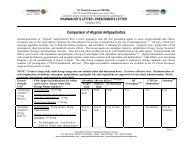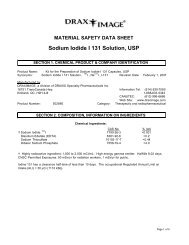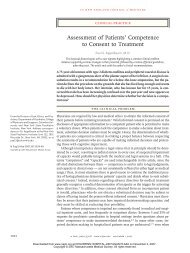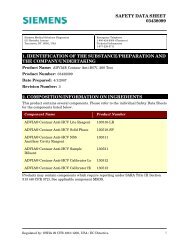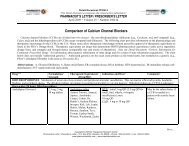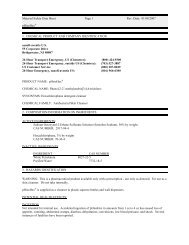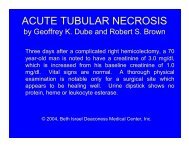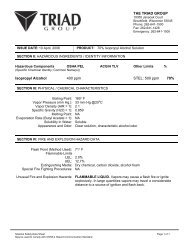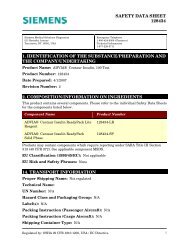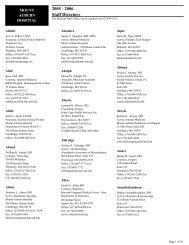Troponin - Non-MI Causes of Troponin Elevation
Troponin - Non-MI Causes of Troponin Elevation
Troponin - Non-MI Causes of Troponin Elevation
You also want an ePaper? Increase the reach of your titles
YUMPU automatically turns print PDFs into web optimized ePapers that Google loves.
Cooperative Pulmonary Embolism Registry (ICOPER). Lancet1999; 353:1386–138910 Ribeiro A, Lindmarker P, Juhlin-Dannfelt A, et al. EchocardiographyDoppler in pulmonary embolism: right ventriculardysfunction as a predictor <strong>of</strong> mortality. Am Heart J 1997;95:67–6811 Como-Canella I, Gamello C, Martinez-Onsurbe O, et al.Acute right ventricular infarction secondary to a massivepulmonary thromboembolism. Eur Heart J 1988; 9:534–54012 Adams JE III, Seigel BA, Goldstein JA, et al. <strong>Elevation</strong> <strong>of</strong>CK-MB following pulmonary embolism: a manifestation <strong>of</strong>occult right ventricular infarction [letter]. Chest 1994; 105:161713 Giannitis E, Muller-Bardorff M, Volkhard K, et al. Independentprognostic value <strong>of</strong> cardiac troponin T in patients withconfirmed pulmonary embolism. Circulation 2000; 102:211–21714 Goldhaber SZ. Treatment <strong>of</strong> acute pulmonary embolism. In:Braunwald E, Goldhaber SZ, eds. Atlas <strong>of</strong> heart disease.Vol 3. Cardiopulmonary diseases and cardiac tumors. Philadelphia,PA: Current Medicine, 199515 Douketis JD, Crowther MA, Stanton EB, et al. Elevatedcardiac troponin levels in patients with subacute pulmonaryembolism. Arch Intern Med 2002; 162:79–8116 Muller R, Gould L, Betzu R, et al. Painless myocardialinfarction in the elderly. Am Heart J 1990; 119:202–20417 Missov E, Calzolari C, Pau B. Circulating cardiac troponin Iin severe congestive heart failure. Circulation 1997; 96:2953–295818 La Vecchia L, Mezzena G, Ometto R, et al. Detectable serumtroponin I in patients with heart failure nonmyocardial ischemicorigin. Am J Cardiol 1997; 80:88–9019 Missov E, Mair J. A novel biochemical approach to congestiveheart failure: cardiac troponin T. Am Heart J 1999; 138:95–9920 Setsuda K, Seino Y, Takahashi N, et al. Clinical significance <strong>of</strong>elevated levels <strong>of</strong> cardiac troponin T in patients with chronicheart failure. Am J Cardiol 1999; 84:608–61121 Perna ER, Macin SM, Parras JI, et al. Cardiac troponin Tlevels are associated with poor short- and long-term prognosisin patients with acute cardiogenic pulmonary edema. AmHeart J 2002; 143:814–82022 Guler N, Bilge M, Eryonucu B, et al. Cardiac troponin Ilevels in patients with left heart failure and cor pulmonale.Angiology 2001; 52:317–32223 Cummins B, Auckland ML, Cummins P. Cardiac-specifictroponin-I radioimmunoassay in the diagnosis <strong>of</strong> acute myocardialinfarction. Am Heart J 1987; 113:1333–134424 Smith SC, Ladenson JH, Mason JW, et al. <strong>Elevation</strong>s <strong>of</strong>cardiac troponin I associated with myocarditis, experimentaland clinical correlates. Circulation 1997; 95:163–16825 Ammann P, Fehr T, Minder EI, et al. <strong>Elevation</strong> <strong>of</strong> troponinI in sepsis and septic shock. Intensive Care Med 2001;27:965–96926 ver Elst KM, Spapen HD, Nguyen DN, et al. Cardiactroponins I and T are biological markers <strong>of</strong> left ventriculardysfunction in septic shock. Clin Chem 2000; 46:650–65727 Arlati S, Brenna S, Prencipe L, et al. Myocardial necrosis inICU patients with acute non-cardiac disease: a prospectivestudy. Intensive Care Med 2000; 26:31–3728 Spies C, Haude V, Fitzner R, et al. Serum cardiac troponin Tas a prognostic marker in early sepsis. Chest 1998; 113:1055–106329 Hinshaw LB. Sepsis/septic shock: participation <strong>of</strong> the microcirculation;an abbreviated review. Crit Care Med 1996;24:1072–107830 Kollef MH, Ladenson JH, Eisenberg PR. Clinically recognizedcardiac dysfunction: an independent determinant <strong>of</strong>mortality among critically ill patients. Chest 1997; 111:1340–134731 Hamm CW, Giannitsis E, Katus HA. Cardiac troponin elevationsin patients without acute coronary syndrome. Circulation2002; 106:2871–287232 Guest TM, Ramantham AV, Tuteur PG, et al. Myocardialinjury in critically ill patients: a frequently unrecognizedcomplication. JAMA 1995; 273:1945–194933 Bodor GS, Porterfield D, Voss EM, et al. Cardiac troponin Iis not expressed in fetal and healthy or diseased adult humanskeletal muscle tissue. Clin Chem 1995; 41:1710–171534 Fitzmaurice TF, Brown C, Rifai N, et al. False increase <strong>of</strong>cardiac troponin I with heterophilic antibodies. Clin Chem1998; 44:2212–221435 Schifman RB, James SH, Sadrzadeh SMH, et al. Betweenassayvariation in false positive troponin I measurements inpatients on renal dialysis or with positive rheumatoid factor[abstract]. Clin Chem 1999; 45:A14536 Nosanchuk JS. False increases <strong>of</strong> troponin I attributable toincomplete separation <strong>of</strong> serum [letter]. Clin Chem 1999;45:71437 Galambos C, Brink DS, Ritter D, et al. False-positive plasmatroponin I with the AxSYM analyzer. Clin Chem 2000;46:1014–101538 Dasgupta A, Banjiree SK, Datta P. False positive troponin I inthe MEIA due to the presence <strong>of</strong> rheumatoid factors inserum. Am J Clin Pathol 1999; 112:753–75639 Covinsky M, Laterza O, Pfeifer JD, et al. An IgM antibody toEscherichia coli produces false-positive results in multipleimmunometric assays. Clin Chem 2000; 46:1157–116140 Boscato LM, Stuart MC. Incidence and specificity <strong>of</strong> interferencein two-site immunoassays. Clin Chem 1986; 32:1491–149541 Kricka LJ. Human anti-animal antibody interference in immunologicassays. Clin Chem 1999; 45:942–95642 Thompson RJ, Jackson AP, Langlios N. Circulating antibodiesto mouse monoclonal immunoglobulins in normal subjects:incidence, species specificity, and effects on a two-site assayfor creatine kinase-MB isoenzyme. Clin Chem 1986; 32:476–48143 Kim WJ, Lazerta OF, Hock KG, et al. Performance <strong>of</strong> arevised cardiac troponin method that minimizes interferencesfrom heterophilic antibodies. Clin Chem 2002; 48:1028–103444 Carey G, Lisi PJ, Schroeder TJ. The incidence <strong>of</strong> antibodyformation to OKT3 consequent to its use in organ transplantation.Transplantation 1995; 60:151–15845 Posnet DN, Edinger J. When do microbes stimulate rheumatoidfactor? J Exp Med 1997; 185:1721–172346 Vaidya HC, Beatty GB. Eliminating interference from heterophilicantibodies in a two-site immunoassay for creatininekinase MB by using Fab conjugate and polyclonal mouse IgG.Clin Chem 1992; 38:1737–174247 Yeo KT, Storm CA, Li Y, et al. Performance <strong>of</strong> the enhancedAbbott AxSYM cardiac troponin I reagent in patients withheterophilic antibodies. Clin Chim Acta 2000; 292:13–2348 Turpeinen U, Lehtovirta P, Stenman UH. CA125 determinedby three methods in samples from patients with humananti-mouse antibodies (HAMA). Clin Chem 1995; 41:1667–166949 Cole LA, Rinne KM, Shahabi S, et al. False positive hCGassay result leading to unnecessary surgery and chemotherapyand needless occurrences <strong>of</strong> diabetes and coma. Clin Chem1999; 45:313–31450 Sosolik RC, Hitchcock CL, Becker WJ. Heterophilic antibodiesproduce spuriously elevated concentrations <strong>of</strong> the MBisoenzyme <strong>of</strong> creatine kinase in a selected patient population.Am J Clin Pathol 1997; 107:506–510www.chestjournal.org CHEST / 125 /5/MAY, 2004 1883



